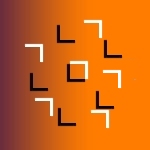
ISSN 2364-3641
Publications:
direct access:
vpl-reports.de
Open Access
| home | evaluation | archive | vpl-goettingen.de | impressum |
|
VPL-reports, 12, 1-32
The paradigm of cued visual selection was used to measure the identification speed of single
targets and target pairs in large item arrays. Four target categories were tested: oblique lines
(orientation, Exp.1 and 5a), vertical bars with the upper and lower halves slightly displaced
(Vernier's, Exp.2), T letters at four orientations (T's, Exp.3), and red or green oblique lines
(conjunctions, Exp.4 and 5). In all experiments, performance with double targets in various distances
from another was compared with that for single targets at the same presentation time. Despite
reported differences in the need of attention for their discrimination, all four target types
revealed similar performance characteristics in the task. The identification of double targets was
strongly disturbed at near target distances (2.5 deg), slightly disturbed at medium distances
(6.5 deg), and not or only little disturbed at far target distances (12 deg). Also the identification
of individual targets in target pairs was usually worse than that of single targets, except at far
distances. In later analysis, target pairs were also distinguished whether they had been located in
same or different visual hemifields. It turned out that all near target pairs were located in same,
all far target pairs in different hemifields. To disentangle hemifield from distance variations, a
new set of target positions was tested (Exp.5), in which near and far distances occurred both within
and across hemifields. The results revealed a clear predominance of hemifield effects. The
identification of target pairs presented in same hemifields was notably worse than the identification
of target pairs presented in different hemifields. Distance variations had almost no effect. In an
aside finding, the study collected further evidence for an independent feature processing in
conjunctions; the color of colored lines was always faster identified than their orientation (Exp.4).
This questions the need of attentional binding processes in the identification of certain conjunction
targets.
|
Download pdf ppt of figures Comments: |
©